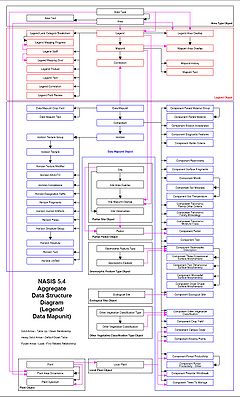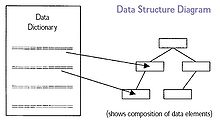- Data structure diagram
-
A Data Structure Diagram (DSD) is a data model used to describe conceptual data models by providing graphical notations which document entities and their relationships, and the constraints that binds them.
The basic graphic elements of DSDs are boxes, representing entities, and arrows, representing relationships. Data structure diagrams are most useful for documenting complex data entities.
Overview
Data Structure Diagram is a diagram type that is used to depict the structure of data elements in the data dictionary. The data structure diagram is a graphical alternative to the composition specifications within such data dictionary entries..[1]
Data structure diagrams are an extension of the entity-relationship model (E-R model). In DSDs, attributes are specified inside the entity boxes rather than outside of them, while relationships are drawn as boxes composed of attributes which specify the constraints that bind entities together. The E-R model, while robust, doesn't provide a way to specify the constraints between relationships, and becomes visually cumbersome when representing entities with several attributes. DSDs differ from the E-R model in that the E-R model focuses on the relationships between different entities, whereas DSDs focus on the relationships of the elements within an entity and enable users to fully see the links and relationships between each entity.
There are several styles for representing data structure diagrams, with the notable difference in the manner of defining cardinality. The choices are between arrow heads, inverted arrow heads (crow's feet), or numerical representation of the cardinality.
- Data flow diagram
- Entity-relationship diagram
- Unified Modeling Language
References
- ^ Data Integration Glossary, U.S. Department of Transportation, August 2001.
Further reading
- Charles W. Bachman. Data structure diagrams. Data Base, 1969, 1(2):4–10.
- Tom DeMarco. Structured Analysis and System Specification. ISBN 0-13-854380-1. Prentice Hall. May 11, 1979.
- Edward Yourdon. Modern Structured Analysis. ISBN 0-13-598624-9. Prentice Hall. August 1, 1988; now available as the Structured Analysis Wiki.
Categories:- Data modeling diagrams
Wikimedia Foundation. 2010.


